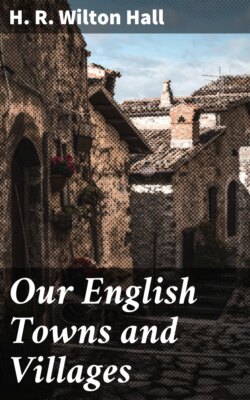Читать книгу Our English Towns and Villages - H. R. Wilton Hall - Страница 8
На сайте Литреса книга снята с продажи.
CHAPTER IV
EARTHWORKS, MOUNDS, BARROWS, ETC.
ОглавлениеTable of Contents
1. There are still remaining, in many parts of the country, curious mounds and stones. We can say very little about them here; but though learned men have discovered much, there is still a good deal to be explained concerning them. Old-world stories put most of these strange objects down to the work of witches, fairies, or giants; some ascribe them to the Romans, or to Oliver Cromwell; others even to the devil. But most of them really belong to this period of which we are speaking—the very early part of our history, of which there is no written record.
2. Earthworks are of many kinds, but the very earliest are usually found on hilltops. There are some which enclose considerable spaces of ground, bounded by an earthen rampart, with a ditch outside. Sometimes there are two such ramparts. Frequently they are spoken of as British Towns or British Camps. They appear to have been enclosures into which the cattle were driven in time of danger, and in which a whole tribe could take refuge and hold out against their enemies.
3. Then there are big mounds or heaps, called Barrows. Some of these are oval in shape, and are called Long Barrows; others are round, and are called Round Barrows. The Long Barrows are thought to be the older kind, and were apparently the burial-places of great leaders. The Round Barrows were also burial-places; but those who raised them burned their dead. The great pyramids of Egypt are barrows, only they are made of stone, not of earth.
Round Barrow; Long Barrow; Twin Barrow
4. The circles of stones at Stonehenge and Avebury seem to have been connected with the worship of these early people. There are many single stones, especially in Cornwall and Wales, which also seem to have been connected with religious rites; but of this we know nothing for certain. In later times they have served as boundary marks.
White Horse Hill
5. In various parts of England there are deep lanes or cuttings, which have received curious local names. There are no less than twenty-two such cuttings in different parts of England all known as Grim's Ditch. These, no doubt, formed boundaries, separating various tribes.
6. The White Horse, cut out of the slope of Uffington Hill, and several similar objects in Wiltshire, as well as the crosses—also cut in the turf—at Whiteleaf and Bledlow, may also belong to this period. Some learned men, however, have thought that they are of a later date.
7. From these early men then the Ancient Britons appear to have descended, and they were settled here a good many centuries before the coming of the Romans. Many of the wild tales and legends, still told in country villages, about giants and fairies, have come down to us from these early times.
Summary.—There are many curious mounds and stones, about which wild tales are told. Earthworks are of various kinds. Those enclosed by an earthen wall or rampart are often called British towns or camps. They were places of refuge. There are two kinds of mounds, called Long Barrows and Round Barrows. Both were burial-places. The Long Barrows belonged to the older race. Stone circles, like those at Stonehenge and Avebury, had something to do with worship, and there are many stones in Cornwall and Devon which most likely were put to the same use. There are twenty-two old trackway boundaries in England all called Grim's Ditch. The White Horse and several other cuttings in the turf possibly belong to this same period. The old legends and tales about all these are worth keeping in mind, though at present we do not understand them.
